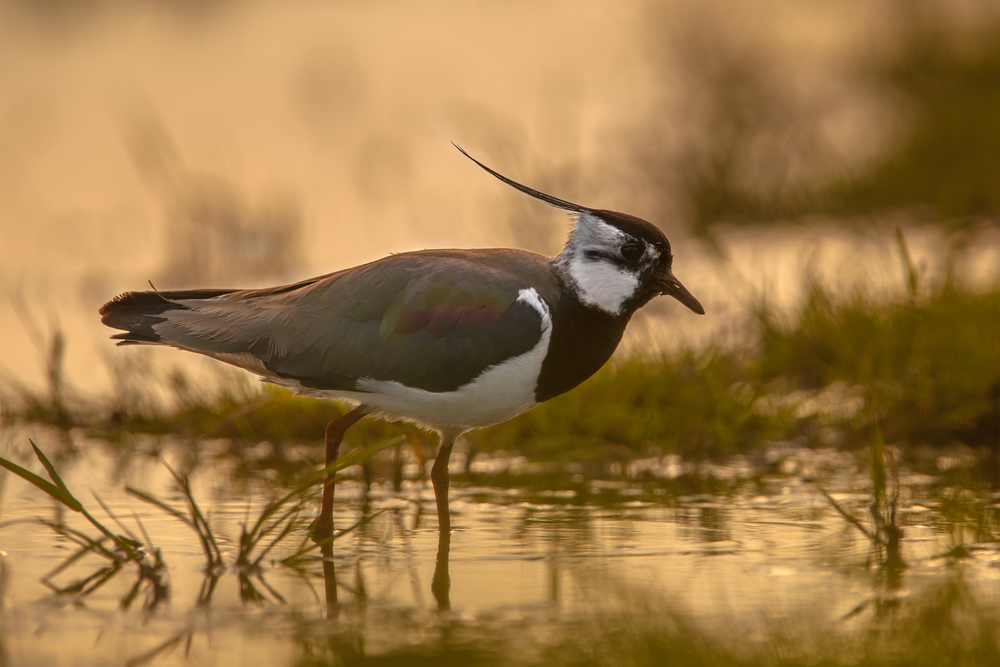
The lapwing relies on the wet heathland habitats found on the New Forest.
I’m really enjoying my walks on the New Forest at the moment. I start very early in the morning, when there are few people about, and often arrive just in time to see the sun appearing over the horizon. As the mist rises from the valleys the sound of the dawn chorus permeates the chill, damp air. This melodic spring repertoire is a pleasant start to the day and a gentle way to waken my senses. As I walk the tracks and footpaths I listen out for the lapwing (Vanellus vanellus). It’s a sound that reminds me of my childhood and brings back many happy memories associated with the countryside. I love to hear the plaintive “peewit” cry of its flight-song as it drifts across the misty skies and I watch as the bird circles its nesting grounds in the eerie half-light of dawn. The lapwing is easily recognisable due to its upsweeping black crest and petrol-coloured plumage. It has many vernacular names, including chewit, dotterel, green plover, peasiewheep, teewhup, ticks nicket, toppyup, and tuefit, which is testimony to its long association with the countryside throughout the British Isles. The wetland sites of the New Forest, such as the mires, bogs and wet heathland, are critically important in providing valuable habit for lapwing populations. The intensive grazing of the ponies and other land management techniques, such as controlled burning, help to maintain the habitat on which these birds depend.
Lapwing superstitions and stories
Its name – lapwing – is supposed to derive from the sound its large wings make when in flight, or from its strategy of drawing predators away from its nest by trailing its wing as if it were broken. It was this form of defence that, according to superstition, makes the lapwing an unlucky bird for those that hear it. In southern Scotland covenanters hiding from the forces of Charles II were given away by the cries of the lapwings defending their nests. The lapwing is, therefore, given credit for being the watchdog for other wading bird species. In some communities the lapwing’s cry of “peewit” is heard as “bewitched”, making people believe that it is associated with witchcraft and sorcery and in others it was believed that lapwings contained the spirits of people ‘who still haunt the earth, in consequence of something that troubles them.’ Catherine Earnshaw, the heroine in Wuthering Heights, is concerned at one point that Heathcliff has killed lapwings and stuffed their feathers in her pillow and begins ‘removing its contents in handfuls’.
Our feathered friends
Not all the stories about lapwings are ominous, though, and there are historical accounts of these birds being successfully kept as pets in Victorian times. In one report a young lady, who also had a terrier dog, kept a lapwing. The bird and the dog, by all accounts, were on the best of terms. The lapwing liked to occupy the kitchen garden and whenever the dog passed that way ‘he was sure to be joined by his feathered friend’. This friendship continued happily for some time until, unfortunately, the bird ‘fell a cruel sacrifice to some half-starved cat’. The biggest threat to lapwing populations in the New Forest is us -disturbance from human recreational activities, particularly dog walking. Our adored pets become voracious hunters when let off the leash. So we need to be aware of our impact on the breeding populations of ground nesting birds and support our feathered friends, from March to July, by staying on the footpaths and keeping dogs in sight and under control. This small concession will ensure that future visitors will be able to enjoy the sight and sound of this distinctive bird and the many others that share the New Forest.

The New Forest swathed in dawn mist is a sight that rewards the early riser.


You must be logged in to post a comment.